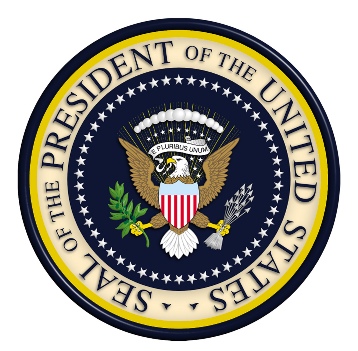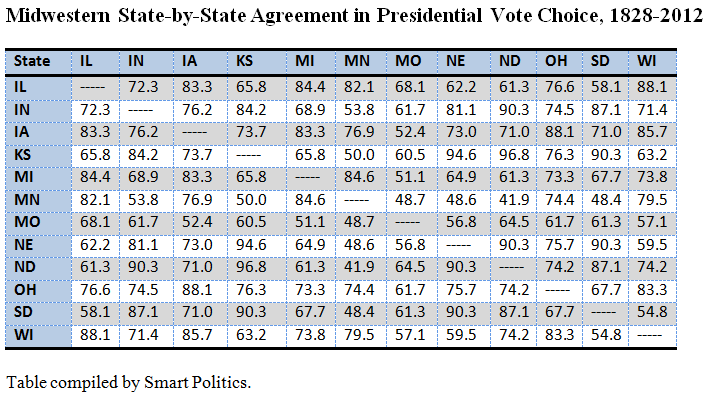Midwestern Sister States and Distant Cousins in Presidential Elections
Two Midwestern states have been in accord on their presidential vote choice 96 percent of the time while another pair has voted in concert during just 41 percent of such elections

Last week, Smart Politics (narrowly) crowned Iowa as the ‘most Midwestern state’ in presidential elections, documenting how the Hawkeye State has voted more closely for the presidential nominees backed by states in the region (76.2 percent of the time) than any of its 11 neighbors in the Midwest.
In a follow-up to that report, Smart Politics breaks down the region’s presidential vote across the 2,485 state-by-state combinations since the birth of the two-party system in 1828.
Which two states have voted in accord more than any other pair during this 47-cycle span and which have done so the least?
The 90 Percent Club
Overall, six pairs of Midwestern states have voted for the same nominee in at least 90 percent of presidential elections.
At the top are the Republican strongholds of Kansas and North Dakota with their vote choice for president aligning in 30 of 31 cycles since the latter achieved statehood, or 96.8 percent of the time.
The only cycle in which the two states were not in accord was in 1896 when North Dakotans voted for William McKinley and Kansans backed William Jennings Brian.
Both states cast their Electoral College votes for President McKinley four years later in 1900 and have now voted together in 29 consecutive cycles.
Close behind, Kansas and neighboring Nebraska have voted in concert in 35 of 37 cycles, or 94.6 percent of the time, including each of the last 26 elections since 1912.
In 1892, Kansas narrowly voted for Populist James Weaver while Nebraska backed President Benjamin Harrison.
Sixteen years later, the two states split for the final time in a presidential contest with Kansas voting for William Taft and Nebraska backing favorite-son William Jennings Byran.
Four other pairs of Midwestern states have been in agreement in their presidential vote choices 90.3 percent of the time (28 out of 31 cycles for each):
● Indiana and North Dakota: every cycle except 1892, 1916, 2008
● Nebraska and North Dakota: except 1892, 1896, 1908
● Nebraska and South Dakota: except 1908, 1912, 1916
● Kansas and South Dakota: except 1892, 1912, 1916
Overall, Kansas has been the most simpatico Midwestern neighbor in presidential vote choice for three states (Nebraska, North Dakota, South Dakota), with Illinois for two (Missouri, Wisconsin), North Dakota for two (Indiana, Kansas), and Iowa (Ohio), Michigan (Minnesota), Minnesota (Michigan), Nebraska (South Dakota), Ohio (Iowa), and Wisconsin (Illinois) for one each.
From Sister States to Distant Cousins
But not all Midwestern states have spoken with a unified voice when it comes to picking a president.
Overall, 13 of the 66 state-by-state pairings resulted in voter agreement less than 60 percent of the time.
The two states with the least in common in presidential vote choice are Minnesota and North Dakota in just 41.9 percent of elections (13 of 31 cycles).
Since 1940, Minnesotans and North Dakotans have chosen the same presidential nominee in just four of 19 cycles – last doing so in 1972 with Richard Nixon.
Minnesota holds the distinction of being the state with which six Midwestern states have voted the least in the region: Indiana (53.8 percent), Kansas (50.0 percent), Missouri (48.7 percent), Nebraska (48.6 percent), North Dakota (41.9 percent), and South Dakota (48.4 percent).
Missouri has had the least overlap in presidential vote choice for three states (Iowa, Michigan, Ohio) with South Dakota at two (Illinois, Wisconsin), and North Dakota at one (Minnesota).
The voting records for Missouri and Minnesota had the least resemblance to the Midwestern region overall, voting for the presidential nominees selected by other states just 58.5 percent and 63.4 percent of the time respectively.
Illinois
Sister State: Wisconsin (88.1 percent, 37 of 42 cycles)
Distant Cousin: South Dakota (58.1 percent, 18 of 31)
Indiana
Sister State: North Dakota (90.3 percent, 28 of 31)
Distant Cousin: Minnesota (53.8 percent, 21 of 39)
Iowa
Sister State: Ohio: (88.1 percent, 37 of 42)
Distant Cousin: Missouri (52.4 percent, 22 of 42)
Kansas
Sister State: North Dakota (96.8 percent, 30 of 31)
Distant Cousin: Minnesota (50.0 percent, 19 of 38)
Michigan
Sister State: Minnesota (84.6 percent, 33 of 39)
Distant Cousin: Missouri (51.1 percent, 23 of 45)
Minnesota
Sister State: Michigan (84.6 percent, 33 of 39)
Distant Cousin: North Dakota (41.9 percent, 13 of 31)
Missouri
Sister State: Illinois (68.1 percent, 32 of 47)
Distant Cousin: Minnesota (48.7 percent, 19 of 39)
Nebraska
Sister State: Kansas (94.6 percent, 35 of 37)
Distant Cousin: Minnesota (48.6 percent, 18 of 37)
North Dakota
Sister State: Kansas (96.8 percent, 30 of 31)
Distant Cousin: Minnesota (41.9 percent, 13 of 31)
Ohio
Sister State: Iowa (88.1 percent, 37 of 42)
Distant Cousin: Missouri (61.7 percent, 29 of 47)
South Dakota
Sister State: Kansas and Nebraska (90.3 percent, 28 of 31)
Distant Cousin: Minnesota (48.4 percent, 15 of 31)
Wisconsin
Sister State: Illinois (88.1 percent, 37 of 42)
Distant Cousin: South Dakota (54.8 percent, 17 of 31)
Follow Smart Politics on Twitter.

